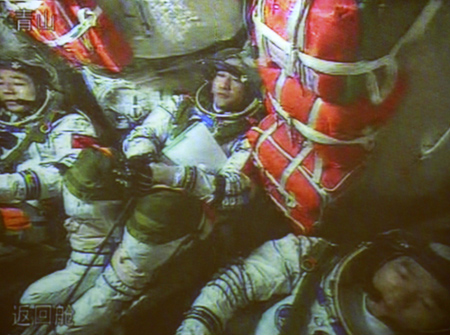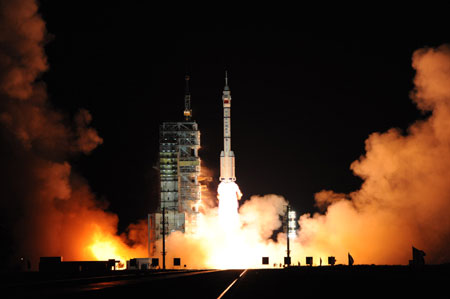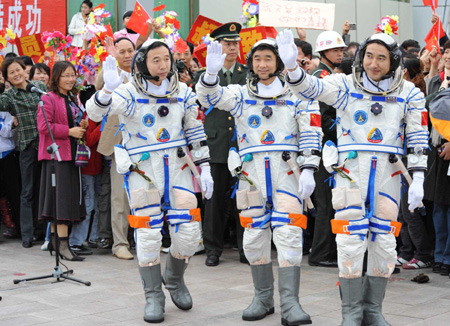Shenzhou VII launched for 1st spacewalk
China's third manned spacecraft lifted off at 9:10 pm on Thursday to fulfill its most ambitious and risky mission: spacewalk.
Shenzhou VII, carrying astronauts Zhai Zhigang, Liu Boming and Jing Haipeng, blasted off from the Jiuquan Satellite Launch Center in Gansu province, into a clear sky.
As is the case with such missions, the first few moments were tense. But then the ground control heard the voices of the astronauts. They felt "physically sound", they said to the joy of the scientists on the ground.
|
|
"The solar panel has unfolded, and we feel well," one of them said. Remote-measuring signals showed all their physical indices, such as blood pressure and heartbeat, were normal.
The astronauts will orbit the Earth for three days, 68 hours, to be precise, and one of them will walk in space about 343 km above the Earth on Saturday.
That will make China the third country to conduct extra-vehicular activity (EVA) in space. The other two to have achieved that are the former Soviet Union and the US.
The timing of the spacewalk could, however, be changed, depending on how long it would take for the astronauts to adjust to all the factors. EVAs are essential for China's long-term goal of building a space station by 2020, and possibly launching a manned mission to the Moon.
|
|
Back at the Beijing Aerospace Control Center Thursday, hundreds of scientists monitored and reported the spacecraft's status every few seconds.
At 9:32 pm, Shenzhou VII entered its orbit. A minute later, Chang Wanquan, chief commander of the center, announced that the lift-off had been a complete success.
President Hu Jintao, who was present at the Jiuquan launch center, congratulated the space scientists and the astronauts for the successful lift-off.
"The successful launch marks the first victory of the Shenzhou VII mission," Hu told scientists and other staff at the center. "On behalf of the CPC Central Committee, the State Council and the Central Military Commission, I congratulate all those who are part of the mission."
A few hours before the launch, Hu saw off the three white-suited astronauts on their way to the Long March II-F carrier rocket, which later took them into space.
The spacewalk would be a milestone, he told them. "This will be a major step forward for our country's aerospace technology."
"You can certainly fulfill this glorious and sacred task. The motherland and its people await your triumphant return," he said.
|
 Three Chinese astronauts in the cabin of Shenzhou VII spacecraft wait for launch at the Jiuquan Satellite Launch Center in northwest China's Gansu province on Thursday Sept. 25, 2008. [Xinhua] |
The astronauts will land in central part of the Inner Mongolia autonomous region in a re-entry module.
The astronauts entered the spacecraft at 6:28 pm Thursday, checked the communication system with the ground control after reviewing the operation manual of the spaceship.
The spaceship will change its orbit around 4 am today. And the astronauts will start testing and putting on the EVA spacesuits, which could take up to 15 hours.
China launched its first manned spaceship in October 2003, and followed it up by sending Shenzhou VI two years later. But the Shenzhou VII astronauts have a greater task in hand.
They have a wider choice of dishes too: nearly 80. One of them is spicy kung-pao chicken cooked following a "new method", Chen Bin, the mission's chief nutritionist, told Xinhua.
They will also take traditional Chinese medicine made with more than 10 herbs to treat space motion sickness.
Engineers overseeing the flight have, however, warned of risks. Zhang Jianqi, one of the chief engineers, told Xinhua that keeping the three men in the craft and sending one outside the capsule would be a "big test".
"This is a big technological leap," he said. "The risks are quite high. Sending up three astronauts is a jump both in quantity and quality."
Space motion sickness can cause dizziness, vomiting and nausea. A depressed astronaut could feel severe pain in the joints, have breathing difficulty or could even lose consciousness.
"Some of these can be life-threatening," said Li Yongzhi, director of medical department of the China Astronaut Research and Training Center.
Mission in Numbers
3 days Duration of the Shenzhou VII mission
30 minutes Time to be taken by first Chinese astronaut to walk in space
15 hours Time astronauts will take to assemble and put on the EVA suit
30 plans To deal with emergencies during spacewalk
80 dishes The three astronauts can choose from, including spicy Kung-pao chicken, shelled shrimps and dry fruits. Only 50-odd were on the menu during the 2005 Shenzhou VI mission
105 meters Length of launch tower, equipped with an emergency slideway for astronauts.
220 technical modifications On Shenzhou VI to reach Shenzhou VII stage
343 km Distance of orbit spaceship will fly in above earth
583 seconds After blasting off on carrier rocket, the spaceship will be launched into orbit
Labels: Culture, news, society, Technology



0 Comments:
Post a Comment
Subscribe to Post Comments [Atom]
<< Home